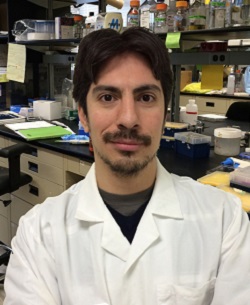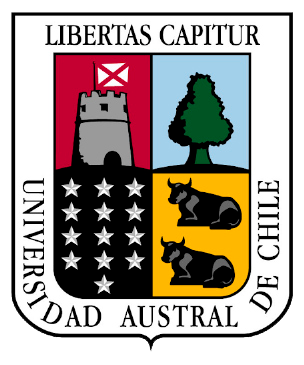Research Lines – Dr. Leandro Carreño

Dr. Leandro Carreño
Alternate Director MIII, Universidad de Chile.
Allergic diseases originate from aberrant immune responses against innocuous non-infectious antigens (allergens), that do not produce inflammatory immune responses in most healthy individual. The predisposition to develop allergic diseases includes genetic and environmental factors. Currently, allergic diseases affect approximately 30% of the population in developed countries, and their prevalence is growing in the United States and worldwide, being a serious problem for public health. Th2 type immune responses are mostly responsible for the pathophysiology of allergic diseases, where Th2 CD4 T cells through the secretion of cytokines, such as IL-4, IL-5 and IL-13, mediate an increase in IgE production (by inducing class-switching in B cells), and the infiltration of inflammatory leukocytes into tissues, such as mast cells, basophils and eosinophils.
In the infiltrated tissue, mast cells, basophils and eosinophils are then activated, and degranulate releasing chemical mediators, such as histamine and leukotrienes, which are responsible for tissue inflammation and injury. In the case of allergic inflammation in the airways, such as during asthma, this response includes bronchoconstriction, airway hyperresponsiveness (AHR) and goblet cell hyperplasia. Recently, it has been shown that a subgroup of natural killer T cells (NKT cells), known as type-1 or invariant NKT cells (iNKT cells) play an important role in allergic diseases, especially in airway hyper-reactivity during asthma. iNKT cells represents a specialized group of unconventional lymphocytes, since they co-express an invariant T cell receptor (TCR) together with multiple receptors that are typically associated with natural killer (NK) cells. The ligand recognized by the TCR of iNKT cells consists on glycolipid antigens bound to the non-polymorphic MHC-I like molecule CD1d. iNKT cells have been reported to modulate the immune function and outcome of anti-pathogen, anti-tumor and autoimmune responses. Recently, iNKT cells were reported by one group to be present in large quantities in bronchoalveolar lavage fluid (BALF) from asthmatic patients, which together with earlier data from mouse models implicated these cells as important players in allergic diseases. Although this study was controversial with others reports showing much smaller numbers of iNKT cells in BALF from asthmatic patients, all the studies consistently shown an increase on iNKT cells in asthmatic patients compared with controls. Importantly, the functional phenotype of iNKT cells during allergic or healthy conditions has not been determined in these studies.
In various animal models of asthma it has been shown that the NKT cells are essential to induce airway inflammation. In addition it has recently been reported that NKT cells necessary to induce an allergic response in a chronic model of allergic conjunctivitis. Importantly, the role of NKT cells has been generally described as crucial in animal models where the dose of allergen is relatively low. This observation is highly relevant, considering that many allergens are found in very low amounts in nature. Because NKT cells secreted much larger amounts of IL-4 and IL-13 Th2 T cells are likely to act through a mechanism of amplification of the response when the antigen dose is limiting.
Once the allergic response is initiated, it has been shown that CD4 Th2 T cells, mast cells and lung epithelial cells are capable of secreting IL-25 and IL-33, which in turn induce the production of IL-5 and IL-13, eosinophilia and IgE production, amplifying the allergic response. Since mast cells and basophils produce much higher quantities of IL-25 and IL-33 than CD4 Th2 T cells, and considering that data obtained in IL-25 KO mice has shown that this cytokine is essential for Th2 immune responses, it is possible that mast cells, basophils and later eosinophils play a role in the regulation of allergic immune responses. Remarkably, it has been recently shown that iNKT cells express in high amounts the IL-25 receptor, IL17RB, while activated CD4 T cells (as found in allergic responses) do not. Importantly, only IL17RB expressing iNKT cells can restore allergen induced airway hyper-reactivity in iNKT cell deficient mice. Thus, a crosstalk between mast cells, basophils, eosinophils and iNKT cells may represent an important mechanism of allergic responses. We are currently evaluating the modulation of NKT cells by non-conventional antigen presenting cells (NC-APCs) during normal and allergic conditions. Since phenotypic changes can occur during the allergic response in this study suggest communication assess cell NC-APCs with CD4 and NKT cells by using an animal model of allergy and tolerance model of allergy.
Furthermore, in order to find NKT cell ligands (glycolipids) that could modulate the balance of Th1 / Th2 response by NKT cells, we have developed a humanized mouse model for NKT cell responses, by knock-in expressing human CD1d. Although this molecule is relatively conserved in humans and mice, there are important differences in their ability to select and activate NKTs cells, since the abundance of these cells in humans is very low compared with mice, making difficult to extrapolate from animal models to humans. Currently, we have characterized NKT cells in the human CD1d knock-in mouse, showing the the abundance and phenotype is very similar to what is found in humans. We are currently evaluating NKT cell responses by an extensive panel of glycolipids using this “humanized” mouse to be later used in models of allergy and infection.






